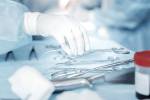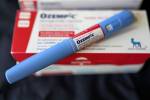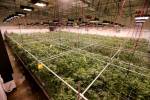Donor program saves lives
By KIMBERLEY MCGEE
VIEW ON HEALTH
A moment in a stranger's life might give one local woman many more to look forward to in hers.
Just five months ago, life was coasting along nicely for Carolyn Hayes Uber. The president of Stephens Press was a bit run down during last year's holiday season, but otherwise everyday was as it should be, a bit hectic but full.
A routine trip to her doctor brought her news that her body was battling Acute Myeloid Leukemia.
"Other than feeling quite tired the last few days before the diagnosis, I didn't have any symptoms," Uber said.
Low white blood counts were revealed during a routine check-up, and subsequent testing showed these vital counts had dwindled significantly. Her doctor ordered a more invasive test, a bone marrow biopsy.
"Even then, I blithely assumed I'd get (a prescription) for iron pills or something simple to get them back up," she said.
She was little prepared for the diagnosis she was to receive. Her life changed forever in the amount of time it took her doctor to say Acute Myeloid Leukemia. Her gifts this season would be delayed and come in the form of a stranger's DNA match from one of the world's largest donor networks, Be The Match.
Through this donor program with 8 million volunteers, Uber would eventually find one person who could save her life by having had their cheek quickly swabbed and entering their information into a national database. The subsequent stem cell donation comes through a relatively easy procedure that involves a few injections and retrieval of the stem cells through blood, not the harrowing marrow transfer of the past.
THE JOURNEY
Uber's journey to Be The Match was just beginning as she sat with her physician that first day of diagnosis.
"My doctor was very blunt about the news," she said, "telling me in a single sentence that I had leukemia and one to four weeks to live unless I received immediate treatment."
Four hours after hearing she had AML, she was admitted to the hospital, where she would remain for the next 45 days.
Acute myeloid leukemia is a cancer that, in most cases, begins in cells that don't mature properly to develop into white blood cells. It tends to start in the bone marrow and later move to the blood and organs if not treated early.
"Numbness best describes my reaction," Uber said. "I just really couldn't take it in and process it."
The physician went on to explain the aggressive chemotherapy that needed to be started immediately, within hours, and the associated risks of that harsh treatment.
"But I heard and understood little," Uber said.
A researcher by nature, it was difficult for Uber to hand over her treatment to strangers, albeit professionals in their field with much more knowledge than she. "Under less urgent circumstances I would have researched this disease, treatment options, and such in order to make informed decisions," she said.
Her oncologist briefly mentioned a stem cell transplant might be an option, "but the bigger challenge of the moment was to go through chemotherapy in an attempt for remission," she said.
The chemo took its toll on her body and spirit, but not for long.
"Because I was immediately very sick from treatments, it was some weeks before I could find the energy to turn on my computer and begin to educate myself on my disease and treatment options," she said.
Her daughters, Tina and Amanda, took the opportunity to step in and help their mother with research.
They found and brought the transplant option to the table, the specialty centers where it could be performed, and the likelihood of finding a match for their newly-diagnosed mother.
"Patients with serious illnesses certainly need advocates to help with these important decisions, and I've been extremely fortunate in that respect," Uber said. "Because the statistics were very scary, I almost didn't want to learn what I needed to know."
Ironically, Uber's daughter Amanda's boyfriend, Matt Seng, had been touched by AML as well. His grandmother had passed away from the disease, prompting him to be more involved with donor programs. Seng is a volunteer for the Be the Match program and he participates in Team in Training marathons to raise research funding for the Leukemia Society.
"He introduced us right away to folks who could help and my family started a campaign to get family and friends to sign up as prospective donors," Uber said. "It is a 'pay it forward' kind of generousness."
She worried over the prospect of a stem cell transplant, as well as the possibility of finding a match.
Her colleague, John L. Smith, told his longtime friend to "live in the moment," advice that had helped pull his school-age daughter Amelia through her own stem cell transplant.
"It is good advice during the dark days," Uber said. "But once I began to feel better, I knew I had to learn all I could, so I began to plot out my future, and it had to include a transplant."
The process to be in the donor registry is a simple cheek swab, and most who sign up will never be called to donate. It takes millions of registrants to find that one prospective donor.
Uber's brother and sister immediately volunteered to be a donor for their sibling. However, only 25 percent of siblings in general are a match.
"Unfortunately, they were not," she said.
The process is not without considerable risk and not everyone survives. There's also the concerns of long term complications, Uber said.
"But I can't dwell on that and I am continually reminded that other than a deadly disease, I'm quite healthy," Uber said. "My attitude is that this is the next step in my journey toward a cure, and I need to get it behind me."
Uber will have the transplant at The City of Hope, a renowned transplant center in Duarte, California. The City of Hope has a "buddy" program that connects potential transplant patients with a transplant survivor to help them through the process.
"Talking to someone who'd 'been there' and was obviously thriving boosted our spirits dramatically," Uber said.
She and her family settled in to wait for the news they had a match in one of the 8 million people who signed up to be a donor with the Be The Match program.
"I was very fortunate that mine was found within weeks," Uber said. "Many people wait months or years."
She was also lucky, she said, in that her match has many DNA markers that line up with hers, increasing her odds of doing well with this transplant.
"Every day I bless the kind generosity of a complete stranger to me, who is willing to undergo the process to donate their stem cells to save my life," she said. She plans to have the procedure in late May. She will go to the hospital a week before the procedure to prepare. A round of chemotherapy will be administered to cleanse her body of white cells and bone marrow. The stem cells will be transplanted via an IV in a hospital bed over a few hours. Uber will then stay in isolation while the stem cells begin producing healthy bone marrow. While her immune system is low, she will receive antibiotics to stave off infection. Just as with organ transplants, rejection is a possibility so Uber will be monitored for any problems. Her stay in the hospital could last from 30 to 100 days, depending on her body's reaction. She will then have another three or four months of isolation as a precaution to infection. She can make a full recovery within two years.
Until then she is working from home a bit and planning her days around her fragile health state. She takes a lot of precautions so as not to compromise her immune system that has been damaged by the chemotherapy.
"I (have to avoid) crowds and public places," Uber said. "Mostly I whine about having to eat only cooked foods, so no salads or fresh fruits. A giant Caesar salad is waiting for me on the other side of my cure!"
One day, she hopes to meet her donor, but that can be a complicated process depending on those involved.
"Of course I would like to meet this person and express an appreciation that can't really even be put in words," she said. "I feel the best I can do is thank everyone who ever took the time to register and let them know that their act of kindness can save the life of someone's mother, father, sister, brother, husband, wife, and most especially, a child."
A DONOR
Eric Hoey, national director for evangelism and church growth for the Presbyterian Church USA, signed up to be a donor 15 years ago.
The Presbyterian priest registered through an Asian program. When his sample came up in 2009 as a match for a man in desperate need of a donor, the Be The Match team set out to find Hoey, who had moved over the years.
"They found me on Facebook," the Kentucky resident recalled. He received the call from the Be The Match program while he was at a conference in Indiana. "They did everything they could to find me. And I'm glad they did, it was important for me to do this."
His first reaction was excitement mixed with urgency. His potential match needed the donation within weeks and the process needed to begin immediately. Hoey went to a local lab for blood work to ensure nothing had changed since his initial cheek swab.
They interviewed him over the phone to make sure he understood and was ready for the physical and mental process. They sent a large packet of paperwork for him to fill out and flew him to California for further testing.
"I felt it was so important for me to do so I didn't mind doing that," he said. "If you are chosen, and not very many people are chosen, it's an opportunity to save a life, and that's a once in a lifetime opportunity. I jumped at it."
His faith as a Christian carried him through any doubts.
"The sacrifice that Christ has done for me I wanted to offer that back to the world," the married father of four said.
Back in his hometown of Louisville, he took injections over four days before flying to California for the final injection and removal of the stem cells from his blood.
"They administer these injections that give you flu-like symptoms, and that was the hardest part," he said. "It's kind of painful. I'm very fit and I work out. But the injections made my legs hurt, like I'd run miles and miles every day."
The femur is the largest producer of marrow in the body, so it was affected the most, causing the leg discomfort.
After five days, the stem cells are released into the blood stream. Once there, it's a simple process of removing the blood, spinning it to retrieve the stem cells, and returning it to the patient. The whole process takes a few hours in a lab or hospital.
"Everything goes numb when they hook you up to the machine," he said. "I was out (of the hospital) in 3.5 hours. It was a challenging 3.5 hours."
It took about a month for Hoey to return to feeling at his peak again, he said. Within a week the flu-like symptoms had begun to abate.
"After a week I still didn't feel like I was at full strength, but everyday you feel stronger," he said. "But I tried to work out after a week and tore myself up. Your body is still producing the stem cells so you still feel like you have the flu for awhile."
While his family was supportive, they had their reservations.
"My family thought I was crazy, 'Why are you going through all this?'," he said. "But I almost feel like it's a moral obligation. I would do it again. It's a great feeling knowing you saved another person's life and that only you can do that."
Although he has never met the person who received his stem cells, he did receive a card with a very simple message.
"It said 'thank you thank you thank you'," Hoey said. "So I know that person is alive."
BE THE MATCH
Be The Match is a national registry that has more than 8 million volunteers who have already given a cheek swab, and 12 million world wide. More than 10,000 patients are in need of a stem cell donor match each year.
"Our primary mission is of course to educate and register people who would like to volunteer to be a match to one of these patients," Oscar Correa, southwest Be The Match recruiter, said.
Because tissue types are inherited, matching to a donor goes along racial ethnic lines.
"One of our primary objectives is to diversify the registry as much as possible," Correa said. "About 30 percent of the time they are going to find a match within the family, outside of the family, a patient will find someone in their racial group."
If you are Caucasian you have a 75 percent chance of finding a match. The probability is 17 percent for African Americans and 50 percent for Hispanics. The odds are lower for Asians; however the Be The Match organization is connected to Japan's sizeable registry, having helped that country set up its initial registry.
Most challenged are American Indians, with only about 70,000 registered, "so that's really challenging there," Correa said.
To become a match, you simply have the inside of your cheek swabbed and the information is put in the registry. Once you are a match, you are asked to give blood samples and then, more than likely, you would have a peripheral blood stem cell procedure. Stem cells were found to be in the blood a little more than a decade ago, making the donation procedure much simpler and relatively painless. Stem cells, which can grow to be any type of blood cell, from a white cell that fights infection to red cells that carry oxygen, are early, immature cells that are produced in the bone marrow.
"There are two ways to donate, traditional bone marrow donation, that's the public's perception, but in the last 12 years that has changed," Correa said.
Today most donations, seven out of 10, use the peripheral blood stem cell procedure
"We discovered you have stem cells in your blood that actually make marrow," he said.
The peripheral procedure is like a plasma donation, where it's a simple needle in the arm to remove the needed stem cells, unlike the bone marrow donation that is often depicted, painfully, in movies and television.
"It's the same technology used for platelet and plasma donation," Correa said.
More than 70 percent of stem cell donations are done this way, Correa said.
"We found we are getting better results with this procedure," he said.
The need for transplants is increasing, Correa said, as is the technology to make it possible for those with life-threatening diseases to survive. Unlike organ donation, participants can donate as often as they physically can. A southwest man has donated four times over the last five years, since he was in high school. The organization has more than a dozen drives each year in Las Vegas. Go to www.bethematch.org for more information and a complete list of future donation drives in the area.
"This is a numbers game, we just need more people to participate," Correa said.





















